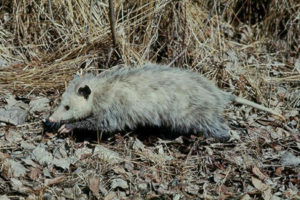 |
|
Opossum |
The Virginia opossum (Didelphis virginiana) is the only marsupial (a pouched mammal) found in North America. The opossum’s habitat is diverse, ranging from woodlands to open fields. They are most commonly found around streams or other wetland areas. In urban areas they seek shelter in attics, garages, chimneys, under houses, or in any other place that offers protection. Although very common in urban areas, opossums are rarely seen because they are nocturnal. Opossums are omnivores and eat a wide variety of foods. Their primary food is animal matter such as insects, earthworms, small rodents, snakes, snails, birds and frogs, but they also eat many kinds of fruits, berries and vegetables. In urban areas, they may eat pet food, fruit on trees, pecans, seeds in bird feeders and garbage in trash cans.
Opossums may become a nuisance in both urban and rural areas. Opossums sometime play “possum” (pretend to be dead) when frightened. Do not approach or attempt to touch an opossum exhibiting this behavior. They frequently “revive” and become extremely defensive. Opossums are capable of transmitting several different diseases. Because opossums salivate heavily, people may assume they are rabid. Even though opossums can potentially transmit rabies, they appear to be very resistant to the disease and are not considered serious rabies vectors. Opossums may also transmit Murine typhus or other diseases to people or pets through the fleas that infest them. Where opossums are common, pet owners should be diligent in controlling fleas on their animals.
Biology and Reproduction
|
Adult weight:
|
4 to 15 pounds.
|
|
Total length:
|
24 to 34 inches.
|
|
Color:
|
Ranges from black to light gray.
|
|
Body:
|
Pointed face, round hairless ears, short legs, and a rat-like tail.
|
|
Gestation:
|
Born 13 days after mating, crawls to mother’s pouch, attaches to a nipple and continues to develop for 7 to 8 weeks.
|
|
Litter size:
|
Average of seven to eight, may have up to thirteen.
|
|
Litter number:
|
Two per year, born year-round.
|
|
Weaning:
|
About 4 months of age.
|
|
Life span:
|
4 years.
|
 |
Control Methods
Mechanical Control
Opossums can be controlled in a number of ways. In rural areas, they can be shot or trapped with leghold traps or cage traps. In urban areas cage traps are the most effective and the safest method of control. Cage traps are available from feed or hardware stores. A cage trap with dimensions of at least 10 inches x 12 inches x 36 inches is adequate. Almost any type of food can be used as bait to catch opossums, although there is less chance of catching a small dog or cat if fruits such as apples, pears or bananas are used.
Environmental Control
Where opossums are causing damage or creating a nuisance, several things can be done to discourage them. Lids should be kept on trash cans; pets should be fed in the morning and all leftovers cleaned up immediately; and water bowls should be emptied or taken in at night. Attic and foundation vents should be screened to discourage opossums from taking up residence in and around the home. Bird feeders should be placed on tall, metal poles and away from trees.
Chemical Control
At the present time there are no toxicants, fumigants or repellents registered for the control of opossums.
Restrictions
Opossums are classified as furbearers in Indiana. Under state law landowners or their tenants may take furbearing animals at any time if they are causing damage. They can also be hunted during the furbearer season with a hunting license. Other furbearers include beaver, mink, skunk, weasel, raccoon, muskrat, fox and coyote. Trapped furbearers must be relocated within the county of capture or euthanized. Permission from the property owner must be obtained prior to releasing an animal on their property. Homeowners who have trapped and relocated or euthanized opossums must report it to IDNR within 72 hours of their catch.
Individuals with nuisance wild animal control permits can assist homeowners with nuisance opossums. The names of licensed nuisance wild animal control operators and additional information can be obtained from the Indiana Wildlife Conflicts Information Hotline at (877) 463-6367.
Acknowledgments
The information given herein is for educational purposes only. Reference to commercial products or trade names is made with the understanding that no discrimination is intended and no endorsement by State or Federal Agencies is implied. This programs serve people of all ages regardless of socioeconomic level, race, color, sex, religion, disability, or national origin. The Wildlife Conflicts Information Hotline is a cooperative program of the United States Department of Agriculture – Animal and Plant Health Inspection Service – Wildlife Services, Indiana Department of Natural Resources-Division of Fish & Wildlife, and Purdue Cooperative Extension Service.